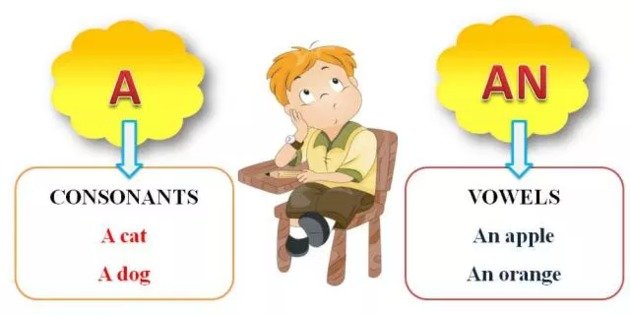Artigos Definidos e Indefinidos em Inglês
Os artigos definidos e indefinidos da língua portuguesa (o, a, os, as, um, uma, uns, umas), na língua inglesa são representados por apenas três artigos: a, an e the e são sempre usados diante de um substantivo.
Artigos Definidos
Os artigos definidos (definite articles, em inglês) são usados sempre que nos referimos a algo específico ou que já foi mencionado em um discurso anterior.
Na língua inglesa, existe apenas um artigo definido, o the, que além de ser usado diante de substantivos no singular, é o único que pode ser usado diante de substantivos no plural.
Em português, ele é traduzido por o, a, os e as.
The car is new. (O carro é novo.)
Pressupõe-se que o receptor da mensagem já saiba de que carro se está falando. Fica implícito que já falaram anteriormente desse carro.
The postcards arrived today. (Os cartões-postais chegaram hoje.)
Fica implícita nessa frase a ideia de que quem recebe esta mensagem, sabe de que cartões-postais se está falando. Para além disso, o fato de a palavra postcards (cartões-postais) estar no plural, apenas permite o uso do artigo definido the.
The backpack is blue. (A mochila é azul.)
A cor (blue) especifica o substantivo (backpack), ou seja, não se trata de uma mochila qualquer, e sim da mochila azul. Aqui também fica implícita a ideia de que já se falou dessa mochila anteriormente e por esta razão, o receptor da mensagem sabe de que mochila se fala.
Sue is drinking an orange juice. The orange juice is cold. (Sue está bebendo um suco de laranja. O suco de laranja está gelado.)
Neste caso, está explícita a ideia de que o substantivo (orange juice) já foi mencionado anteriormente, e por esta razão, já se sabe qual suco de laranja está gelado: o suco de laranja que a Sue está bebendo, e não um suco qualquer.
The girls are playing. (As meninas estão brincando.)
A frase se refere a um grupo específico de meninas, do qual provavelmente já se falou anteriormente, que está brincando e, além disso, o fato de a palavra girls estar no plural, apenas permite o uso do artigo definido the.

Outros usos
O artigo definido the também deve ser usado quando se refere a:
Substantivos únicos na sua espécie
You should use a sunscreen to protect your skin from the sun. (Você deveria usar um protetor solar para proteger sua pele contra o sol.)
That astronaust flew to the moon. (Aquele astronauta voou para a lua.)
Nomes geográficos
He has already been to the North Pole. (Ele já esteve no Polo Norte.)
Adjetivos no plural que assumem função de substantivo
The powerful control the business. (Os poderosos controlam o negócio.)
Nomes compostos de países que já integram o the no seu nome
The United States of America. (Os Estados Unidos da América).
Nomes de família
The Jacksons are a famous family. (Os Jacksons são uma família famosa).
Instrumentos musicais
I like to play the piano. (Eu gosto de tocar piano.)
Ritmos musicais e danças
Carlinhos de Jesus knows how to dance the samba. (O Carlinhos de Jesus sabe dançar o samba.)
Numerais ordinais
This is the first time I visit the zoo. (Essa é a primeira vez que eu visito o zoológico.)
Quando não usar
O artigo definido the não deve ser usado quando a ideia principal da frase se refere a:
Nomes de pessoas
Paula is my sister. (A Paula é minha irmã)
Nomes de lugares
Rio is a beautiful city. (O Rio é uma linda cidade.)
Línguas
Italian is an interesting language. (O italiano é uma língua interessante.)
Esportes
Volleyball is very popular in Brazil. (O voleibol é muito popular no Brasil.)
Disciplinas
Math is very difficult for me. (A matemática é difícil para mim.)
Pronomes possessivos
My father is retired. (O meu pai está aposentado.)
Substantivos no plural usados com sentido geral
Brazilians like soccer. (Os brasileiros gostam de futebol.)
Dias da semana
Sunday is always a boring day. (O domingo é sempre um dia chato.)
Cores
My favorite color is blue. (A minha cor preferida é o azul.)
Cargos acompanhados de um nome próprio
President Kennedy was murdered in 1963. (O presidente Kennedy foi assassinado em 1963)
Expressões de tempo com last e next.
I called him last week. (Eu liguei para ele na semana passada.)
Next Saturday I’m going to the beach. (No próximo sábado eu vou à praia.)
Artigos Indefinidos
Os artigos indefinidos (indefinite articles, em inglês) são usados quando nos referimos a algo em geral, não especificado.
Na língua inglesa existem dois artigos indefinidos, a e an, e eles apenas podem ser usados diante de substantivos no singular. Em português, são traduzidos por um e uma.
O artigo indefinido a é usado diante de substantivos cuja grafia inicie por uma consoante ou por um som de consoante.

As palavras cuja vogal inicial tem, em inglês, som de consoante, geralmente iniciam por “u”, “ew” e “eu” e tem o som da consoante y, ou iniciam por “one” e tem o som da consoante w.
- This is a dictionary. (Isto é um dicionário.)
- That’s a university. (Aquilo é uma universidade.)
- I have a ewe on my farm. (Eu tenho uma ovelha na minha fazenda.)
- A European Journal. (Um jornal europeu.)
- A one-story house. (Uma casa de um andar.)
O artigo indefinido an é usado diante de substantivos cuja grafia inicie por uma vogal ou por um som de vogal.
As palavras cuja consoante inicial tem, em inglês, som de vogal, geralmente iniciam por “h” mudo, ou seja, não pronunciado.
- He is eating an apple. (Ele está comendo uma maçã.)
- She arrived an hour ago. (Ela chegou há uma hora.)
Outros usos
Os artigos indefinidos a e an também devem ser usados quando a ideia principal da frase se refere a:
Profissões
He is a veterinarian. (Ele é veterinário.)
Substantivos contáveis
I bought a skirt. (Eu comprei uma saia.)
Quando não usar
Os artigos indefinidos a e an não devem ser usados quando a ideia principal da frase se refere a:
Substantivos incontáveis
Neste caso, usa-se a palavra some:
I need some advice. (Preciso de um conselho.)
Vídeo
Assista o vídeo abaixo e saiba mais sobre o uso dos artigos definidos e indefinidos em inglês.
Exercícios
Faça os exercícios de artigos definidos e indefinidos em inglês com gabarito.
1. (UNIFOR CE/2006)
Coughing Kitties
Maryann Mott
Feline asthma [TO BE] a new disease. It was first described in scientific literature more than 90 years ago, says veterinarian Philip Padrid of the Family Pet Animal Hospital in Chicago.
Nicki Reed, a veterinarian at the University of Edinburgh’s Hospital for Small Animals, says that when a coughing cat is brought to the clinic, she must first establish if [ARTICLE] cause is [ARTICLE] infection, asthma, or something more sinister, like a lung mass.
To do this, Reed usually performs an x-ray, takes a lung fluid sample, and conducts a bronchcoscopy _ an examination that uses a flexible microscope inserted into the cat’s airway.
Most of the time, asthma is a mild disease, Reed says. But in some cases cat’s lungs collapse or their ribs fracture due to difficulty in breathing.
“I think if we can identify asthmatic cats quite early and get treatments on board to suppress their cough, then hopefully we can avoid them coming to such extremes,” she said.
(Adapted from http://news.nationalgeographic.com/news/2005/10/1025_051025_cat_asthma.html)
In she must first establish if [ARTICLE] cause is [ARTICLE] infection…, the correct forms of the articles are, respectively,
a) the _ an.
b) the _ the.
c) a _ the.
d) a _ an.
e) a _ a.
2. (UFMA/2006)
DISCOVERING NEW YORK
This month TRAVEL magazine will take you to _____ unforgettable journey through _____ most charming and posh places of _____ city claimed to be _____ capital of _____world, New York City.
The Island of Manhattan, one of the five districts of New York, is the richest, most urban and most filled with attractions. The largest green area of the Manhattan Island, with 340 hectares of woods, grass and lakes, Central Park is one of the great surprises in the city.
Fifth Avenue, one of the most famous addresses in the world, marks the middle of the city, like Greenwich Meridian, in London, marks the middle of the Earth. Some of the most expensive and luxurious stores are located there, just like some of the best museums.
A present from the French government to the United States in 1866, The Statue of Liberty is one of the most visited spots in New York. It is not located in Manhattan, but rather in Liberty Island, a small island between Wall Street and Staten Island.
The missing articles in the first paragraph are respectively:
a) a – the – a – the – a.
b) the – a – a – the – the.
c) a – an – the – a – the.
d) an – the – a – the – a.
e) an – the – a – the – the.
3. (URCA CE/2008)
Survival of the cutest
Thousands of creatures will qietly disappear if we only focus on the most fascinating species.
The struggle to preserve the world’s biodiversity is being compromised by fatal flaws in the way conservations draw up their lists of endangered species. An australian botanist warms that the lists reflect the plants and animals that scientists are most interested in studying, rather than the most threatned species or those at risk of extinction. For instance, says Mark burgman of the University of Melbourne, lists compiled and used by organizations such as the World Conservation Union (IUCN) and the Secretariat to the CITES agreement are heavily biased toward birds, mammals and flowering plants, to the detriment of less charismatic species such as insects and fungi. If no one tackles the problem, Burgman believes we will unwittingly focus our conservation efforts in the wrong places, and fail to stop the biggest mass extinction since dinosaurs. Rare species lists contain fewer threatened insects than birds, although we know of nearly a milion insect species and fewer than 10,000 birds. That’s because most insects are poorly studied, says Burgman. For most, all that we have is a specimen in a museum and a brief formal description, he says. Generally, little or nothing is known about their habitat and abundance, and no one may have looked for them since their discovery. ―We assume all’s well because we don’t have any evidence, and we don’t have evidence because we haven’t looked‖, Burgman says. Georgina Mace, director of science athe Zoological Society of London and chair of the Species Survival Comittee, thinks Burgman has identified real problems. Yet she says that groups like the IUCN are adressing them. Starting with amphibians, it has begun assessing the global health of whole groups of related animals, species by species. Putting a species on the Red List is like assessing people coming into a hospital emergency room, she says. It’s not a robust prediction of what will happen, but it’s a quick way to pick out the sickest. But Burgman says that the criteria for assessing whether a species will go extinct vary from country to country and from study to study. He has compared a range of studies and found that different methods produce very inconsisitent results. He says conservation scientists ―need to get our act together‖ and develop a uniform set of tools that everyone can test and agree upon. Even ―extinction‖ can be hard to define, he points out. A surprising number of species have been declared extinct, only to resurface later after people had given up looking for them.
(Jeff Hecht in New Scientists, jan, 2002, p.5)
VOCABULARY:
Struggle – effort; fight Flaw – fault; error
Draw up – compose; design
Threatened – at risk, endangered
Biased – inclined; to be disposed to a certain preference
Tackle (v) – confront, attack
Unwittingly – unintentionally
Brief – short
Pick out (v) – select, choose
Range – variety
Tool – instrument
Resurface (v) – reappear
Choose the correct answer to complete the sentence:
Carol is _________ economist. She used to work in _________ investment department of Loyds bank. Now she works for ______ American bank in ________ United States.
a) a – an – the – the
b) an – a – an – Ø
c) a – an – an – Ø
d) an – the – an – the
e) an – the – Ø – the
4. (EEAR/2007) Choose the alternative in which the definite article is used correctly:
a) The old man is arriving right now.
b) The spring is the season of flowers.
c) The Brazilians are very friendly.
d) The New York is a very beautiful city.
5. (PUC-PR/1996) Fill in the blanks of the following sentence with the definite article:
__________ Brazil is __________ most industrial country in __________ South America, while __________ United States holds __________ same position in _______ North America.
a) the; *; *; *; the; the
b) *; the; *; the; the; *
c) *; the; the; *; the; *
d) the; the; the; the; the; the
e) *; the; the; the; the; *
Saiba mais:
MUNIZ, Carla. Artigos Definidos e Indefinidos em Inglês. Toda Matéria, [s.d.]. Disponível em: https://www.todamateria.com.br/artigos-definidos-e-indefinidos-em-ingles/. Acesso em:



